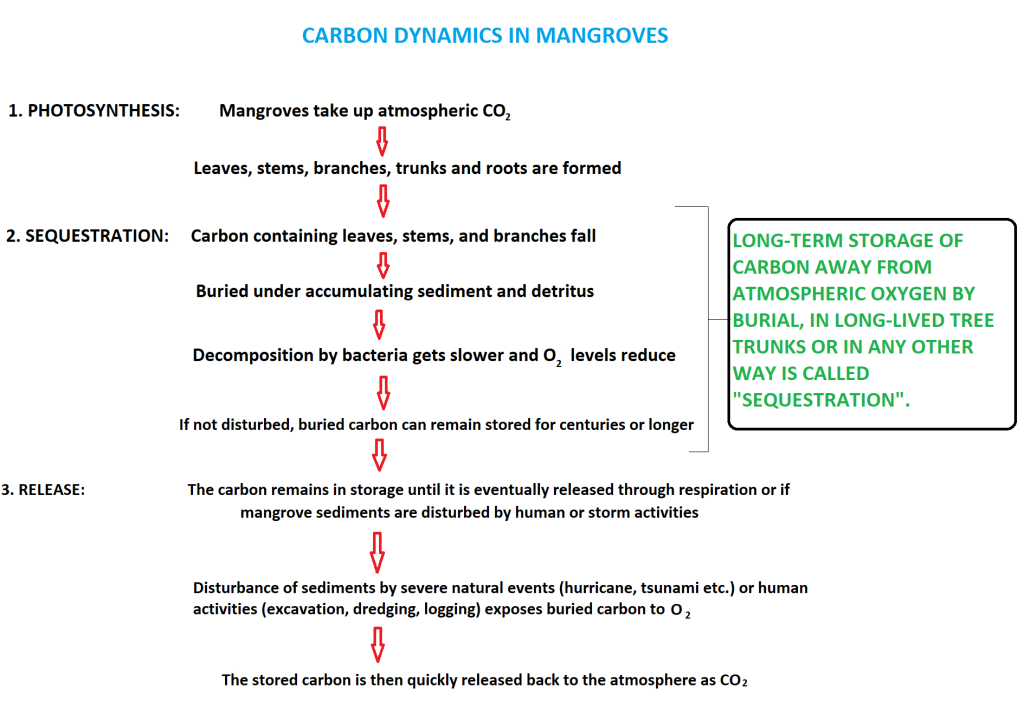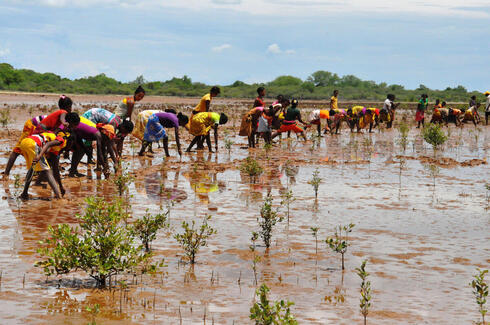Mangroves are critical to fighting the climate crisis. They are natural carbon trappers, helping to mitigate the effects of climate change. As such, these ecosystems are vital nature-based solutions for storing CO2. Mangrove forests are an integral part of the marine coastal ecosystem. These habitats have complex connections to seagrass beds, and coral reefs. Together, they are crucial to sustaining high productivity and biodiversity in our oceans.

In October 2021, at COP15, world leaders sat down to discuss how to make peace with nature. The post-2020 Global Biodiversity Framework formed the heart of this discussion. The framework is a 10-year strategy to engage the entire world in the task of protecting nature. More than that, it’s a strategy to build a future living in harmony with nature. To that end, the framework offers guidance to society and governments. It shows how to work to protect and restore biodiversity in an ambitious and efficient way.
This article will examine the role of mangrove forests in this strategy. How do mangroves protect the oceans? How do they help to mitigate the effects of climate change by serving as carbon trappers? What is impacting their existence? And knowing all this, are we taking enough care of our oceans?
Mangroves and their distribution
Mangroves are a family of evergreen trees and shrubs that live on the coast in the intertidal zone. The upper trunk of a mangrove tree lives completely above the waterline. The lower trunk and the large root system are partly covered by seawater. Many species have roots diverging from stems and branches. They penetrate the soil some distance away from the main stem (like banyan trees).
There are about 80 different species of mangroves. They grow in areas where slow-moving waters allow fine sediments to accumulate. These water-logged soils contain low oxygen levels and can appear like clay or sand. Mangrove forests are only found at tropical and subtropical latitudes near the equator. That’s because they cannot withstand freezing temperatures. Approximately 75% of the world’s mangrove forests grow in just 15 countries.

What makes mangroves so significant?
Mangrove roots
Mangrove forests feature a distinct dense tangle of prop roots. This makes them easy to identify. The roots make the trees appear to be standing on stilts above the water. This tangle of roots allows the trees to handle the daily rise and fall of tides. In fact, most mangroves get flooded at least twice per day. The roots also slow the movement of tidal waters. This causes sediments to settle out of the water and build up the muddy bottom. The intricate root system of mangroves creates vital habitats for other ocean life. They attract fish and other organisms seeking food and shelter from predators. The long root system of mangroves also helps bury carbon deep within the peat soil.

The magical power in mangroves: Blue Carbon (BC)
Mangrove forests are biosequesters. Biosequestration is the process of capturing and storing carbon in living organisms. So, mangroves and the other vegetation along the coast “capture and hold” carbon. In this way, they act as carbon sinks. Carbon sinks play a key role in the cycle of carbon atoms through atmosphere and environment. It’s thus vital to balance the amount of carbon that carbon sinks absorb and release. We need to keep the CO2 concentration in the atmosphere at the best level for survival.

Blue carbon (BC) is carbon captured and stored by marine ecosystems, such as mangroves. This organic process could help us tackle climate change. On earth, BC ecosystems vary greatly in their exposure to climate change. Sea level rise has one of the biggest influences on coastal carbon storage. Sea level rise causes wetlands to adapt by building up more soil from mineral and organic matter. This allows BC ecosystems to capture more carbon. However, factors like oil spills, aquaculture or algal overgrowth can hamper this.
Mangroves as Carbon Sinks
What does a healthy carbon sink look like?

As a healthy carbon sink, this sea captures CO2 from the atmosphere and allows trapping of carbon and nutrients. Whereas, a degraded sea releases carbon in the form of CO2 and methane. Healthy coastal ecosystems have the potential to remove 1.4 billion tons of carbon each year.
How much carbon can a mangrove really store?

Mangroves Vs. Terrestrial forests
By area, coastal habitats can store far more carbon in their soils than trees on land. In fact, they store up to 50 times more than tropical forests, and 10 times more than temperate forests. Unlike terrestrial soils, the sediments of marine ecosystems are largely anaerobic. This means that the carbon decomposes slowly and takes longer to return to the water as carbon dioxide. If sediment accumulates continuously, the organic matter can be sequestered over geological timescales.
As such, the carbon found in coastal soil is often thousands of years old. Coastal blue carbon systems sequester around 4 to 10 tons of CO2 per hectare each year. Thus accounting for almost half of the total carbon sequestered in ocean sediments. This is despite covering less than 2% of the ocean floor.

Mangroves and biodiversity
Important functions of mangrove forests
Mangroves stabilize the coastline by reducing flooding and erosion from storm surges, currents, waves, and tides. They help filter river water of pollutants and trap excess sediment before it reaches the ocean. Mangrove forests are a hybrid of two worlds standing between land and sea. Their branches provide homes for snails, snakes and nesting birds. Whereas their roots, when submerged, become protective nurseries for baby fishes and sanctuaries for marine mammals. Up to 75% of tropical commercial fish species spend part of their lives in mangroves. Their role as fish nurseries can have big impact on local economies and food production. Millions of migratory birds depend on mangroves for food during their journeys.
Mangrove forests provide valuable ecosystem services to coastal human communities. Many people living in and around these forests depend on them for their livelihood. They use the trees for charcoal production, animal fodder, beekeeping, construction wood, fencing, and fuel. They also use the leaves for roof thatching and to make medicines. The ecosystem provides a rich supply of fish, crabs and shellfish to local fishermen. In addition, it promotes ecotourism.
Who lives inside mangroves?
The rich biodiversity of these forests homes microorganisms, algae, invertebrates, fishes, reptiles and amphibians, birds, and mammals. Some of these areas shown.

The plants in mangrove forests
There are three types of mangroves – red, black, and white mangroves.
Red mangroves develop aerial prop roots that keep them above the water with specialized cells in the bark – the lenticels that absorb oxygen and fight hypoxia (low oxygen). The roots reach up to 3m and are divided into four different types: Prop roots, snorkel or peg roots, knee roots, and ribbon or plank roots. These “extensions” enable red mangroves to directly grow in the water on the shoreline. Black mangroves prefer mudflats without being covered by water. They rely on pneumatophores to fulfil the exact same purpose and breathe oxygen from the air. Every tree grows several hundreds of these roots. Thus, sustaining itself within the low oxygen environment. Similarly, white mangroves prefer dry land that only occasionally floods. It filters salt through the trunk of the tree and then excretes via the leaves.
These often grow within the same area, following a zoning pattern from sea to land.

DID YOU KNOW?
A teaspoon of mud from a north Queensland mangrove contains more than 10 billion bacteria. This is a great indication of their incredibly high productivity.
Source: http://igeogers.weebly.com/coastal-ecosystems-conflicts-and-management.html
6 interesting facts about mangroves
- Mangroves can survive in extreme hostile environments, such as high salt and low oxygen conditions.
- Underground tissue of any plant needs oxygen for respiration. But in a mangrove environment, the oxygen in soil is limited or nil. Hence the mangrove root system absorbs oxygen from the atmosphere with special purpose roots called breathing roots or pneumatophores. They have numerous pores through which oxygen enters the tissues.
- Mangrove trees contain a complex salt filtration system and complex root system. This is to cope with saltwater immersion and wave action. The roots filter out 90% of the salt they come into contact with. Some species of mangrove excrete salt through glands in their leaves.
- Like desert plants, mangroves store fresh water in their thick succulent leaves. A waxy coating on the leaves seals in the water and minimises evaporation.
- Mangroves are viviparous. Their seeds germinate while still attached to the parent tree. Once germinated, the seedling grows into a propagule. The mature propagule drops into the water and gets transported to a different spot, eventually rooting in a solid ground.
- Sundarban mangrove forests of India are the largest in the world and the only home for tigers.

Are we responsible for mangrove destruction?
According to a report of the American Museum of Natural History, at the end of the 20th century, less than 50% of the world’s mangrove forests were intact. The remaining are in poor condition. Mangroves are among the most threatened habitats, and their loss is spreading across the globe.
Mangroves are deforested for plenty of reasons. Coastal mangroves are being lost at a rate of 2% per year. The primary threat to mangroves is coastal development including the construction of shrimp farms, hotels and other structures. They are cleared to make room for agricultural land, other forms of aquaculture, and human settlements. In some parts of the world, their overharvesting is still a customary practice. However, it is no longer considered sustainable. Mangroves depend on the presence of freshwater. They can die when dams and other developments stem from the flow of rivers. Overfishing, pollution, and rising sea levels are some other threats to mangroves and their ecosystem.
Efforts in mangrove conservation
Global initiatives, such as the Global Mangrove Alliance has set the goal of increasing the global mangrove area by 20% by 2030, inspiring widespread restoration and rehabilitation projects worldwide. Similarly, the International Blue Carbon Initiative is working to develop management approaches, financial incentives and policy mechanisms. This ensures conservation, restoration and sustainable use of coastal ecosystems. It engages local, national, and international governments to promote policies that support coastal blue carbon management and financing.

Many nations are engaging in REDD+ (Reducing Emissions from Deforestation and forest Degradation). It’s a voluntary process under U.N. Framework Convention on climate change that encourages developing countries to contribute to climate change mitigation. This way they focus on reducing GHG emissions from deforestation and forest degradation.
Conservation International is integrating nature-based solutions into global climate action plans. They can furnish at least 30% of the emission reduction called for under the Paris Agreement and COP26. It’s a critical moment for the Earth’s climate. Government, private-sector, and civil society leaders are supporting natural climate solutions with unprecedented commitments and cash. If sustained and expanded, this can drive rapid progress on climate change. Parallelly, various international commitments on decarbonization are already taking hold.
Role of our communities in saving mangroves
The below video presents the details of various efforts taking their course in conserving these vital forests.
Supporting working organisations in their fight for mangrove conservation by money donations or volunteering is a great way to help them with better protection or reforestation programs. Women and young people are learning how to help with reforestation and carbon monitoring.
Without nature, there is no future. Learn more about combatting climate change and other issues in our monthly webinar series. Together with THRIVE, we can move towards a sustainable and thrivable future.